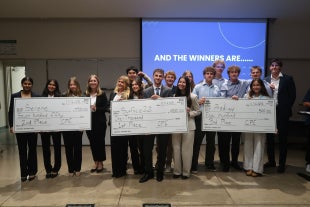Cal Poly Business Professor Says Employees Maintain Leverage at the Workplace Despite Recession Fears
Contact: Pat Pemberton
805-235-0555; ppembert@calpoly.edu
NOTE: Allison Ellis is available for media interviews. Contact Pat Pemberton to schedule.
SAN LUIS OBISPO, Calif. — While fears of an economic downturn have prompted some workers to prioritize job security over quality-of-life preferences, a Cal Poly professor said employees will continue to have leverage gained during the pandemic — and hybrid work models are here to stay.
“I think that we still are in an employee market,” said Allison Ellis, an associate professor of management and human resources at Cal Poly’s Orfalea College of Business. “When you zoom out a little bit, there are long-term trends in the labor market that suggest more broadly that it’s still really difficult to find people with qualifications that companies need today.”

Ellis, who has researched workplace stress and well-being, said employers were seeking ways to improve worker well-being even before the COVID-19 outbreak. And with the pandemic, numerous workplace trends emerged that made employee well-being a central concern for companies and suggested workers had gained the upper hand.
These include: “quiet quitting,” where an employee does the minimum requirements of the job and puts in no more time, effort or enthusiasm than necessary; “The Great Resignation,” an ongoing economic trend in which employees voluntarily resign from their jobs en masse fueled by confidence in being able to quickly find higher-paying jobs; and the hybrid workplace model that combines remote with on-site workers and offers some or all employees the flexibility to choose how and where to work.
“The silver lining of the pandemic situation was that companies were forced to accommodate that situation,” said Ellis of the shift to remote work. “In the past they may have said, ‘Oh, no, we can’t do that.’ Now they had to, and so it kind of showed it’s possible to make these arrangements. And now the decision for companies is: Do we want to keep it this way or not?”
Workplaces can entail many stressors, Ellis notes, including toxic environments and co-workers, lack of resources, job complexity and discrimination. In worst case scenarios, she said, these can adversely impact health and work performance.
Just as employees were enjoying a new shift in the work power balance, though, signs of a troubled economy emerged, leading the New York Times to declare in January, “That era is over,” as the number of quiet quitters quickly dropped.
First it was increased inflation in 2022 and rising interest rates. Then threats of a political standoff over the nation’s debt ceiling began to pose a risk to the stability of the economy. And now tech companies are laying off thousands, prompting the ominous Newsweek headline: “Forget ‘Quiet Quitting,’ 2023 Will Be All About ‘Loud Layoffs.’”
As a result, Newsweek and Forbes, citing recent polls, reported that many American workers have been making fewer demands, suddenly more concerned about just keeping their current jobs. And, as if to acknowledge that lost leverage, some chief executives renounced worker flexibility and demanded employees return to the office full time.
Yet worker fears might be unwarranted. In fact, the U.S. unemployment rate in January was the lowest since 1969, according to a labor report issued earlier this month. So, while many workers once envied tech perks such as high pay, unlimited vacation and free beverages, tech might not offer the best inspiration right now.
“I think people look to tech because in the past they were often exemplars of employee-centered companies,” said Ellis, who suggested it might be better for workers to root for a strong overall economy — one with lots of job openings.
“When workers have more options for working at different companies, they have more leverage in that relationship, and so that empowers people to voice their concerns, like, ‘I want to work from home a couple of days a week,’” she said. “If you’re in a labor market where you have to find a job, and this one is the only option, you might not say that in an interview.”
Accommodating workers can benefit employers, Ellis said, because job satisfaction begets increased performance and decreased turnover. The most consequential workplace shift during the pandemic was requiring most office workers to perform their jobs remotely. Thirty percent of full paid U.S. working days are done remotely, according to the New York Times. And it seems to be a positive trend: A poll by ZipRecruiter, a nationwide marketplace for job seekers and employers, concluded that job seekers would accept a 14 percent pay cut to work from home.
At the same time, Ellis said, remote work can also lead to feelings of isolation and a disconnect from co-workers.
“There’s a lot of research that’s showing the sense of connection and belonging that people have in their workplace is really important,” Ellis said, “which I think has been challenged a little bit with the COVID pandemic and so much remote work.”
A hybrid model — the most common remote work situation, according to The New York Times — offers stress-reducing flexibility and a sense of connection.
“People have been saying for a long time that the 8-to-5 work week started when we were in manufacturing plants, and it doesn’t apply anymore,” said Ellis, who thinks hybrid models will endure.
Employers will likely support hybrid models if they spur positive results. However, remote work also makes it more tempting to reply to those emails after hours, on weekends and during vacations — posing a new worker stress threat.
“Then the onus becomes both on people to manage their boundaries — that’s difficult for a lot of people to do — and on organizations to create cultures that allow people to disconnect when they’re not working,” Ellis said. “‘Yes, we have this hybrid model, but the expectation isn’t that you are on 24/7 — because that’s not conducive to engagement and productivity.’”


